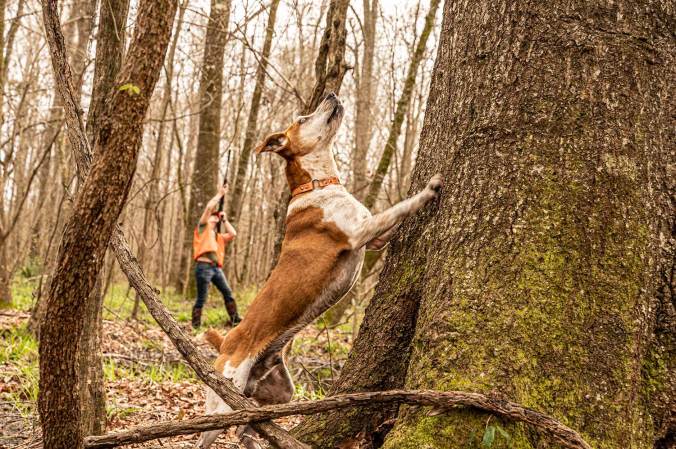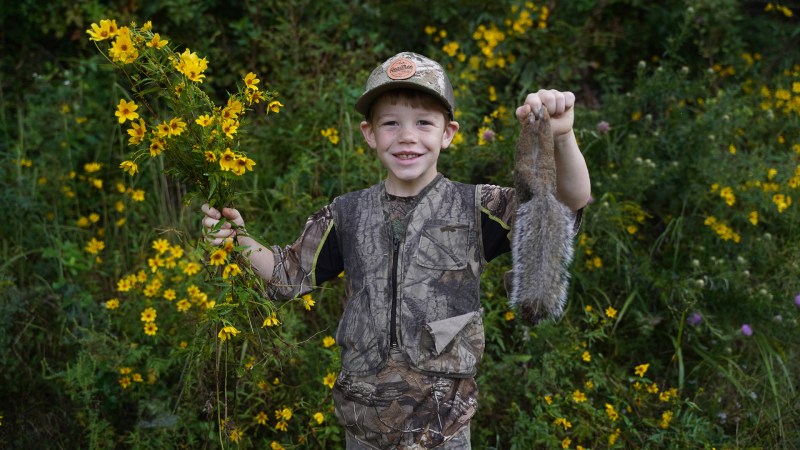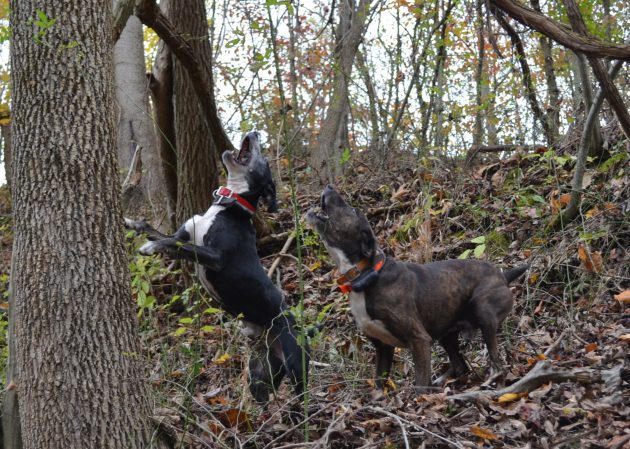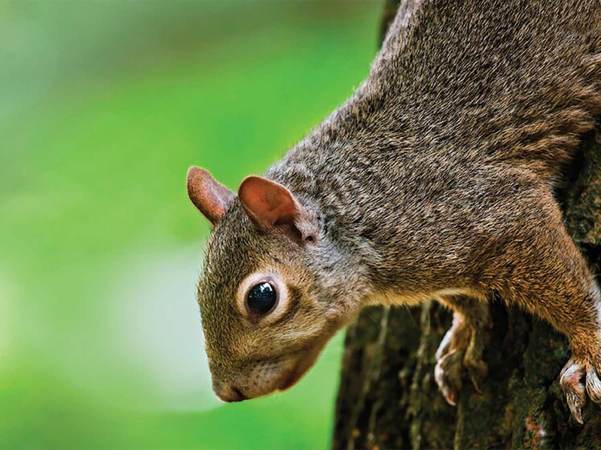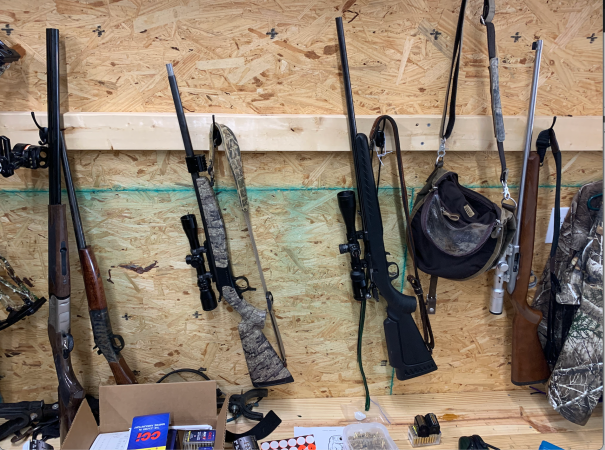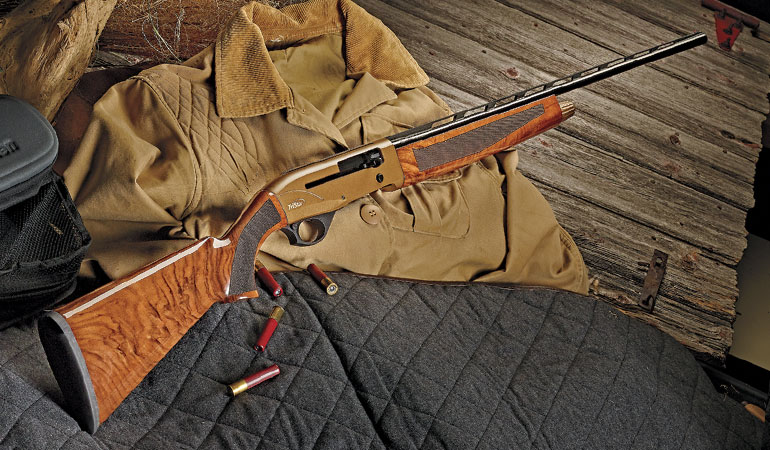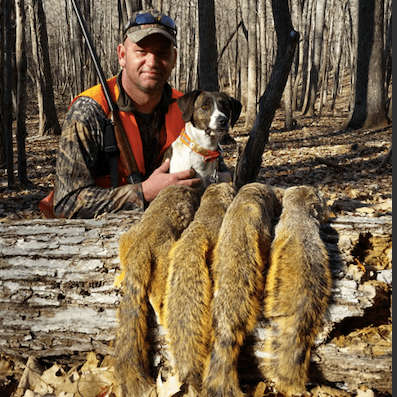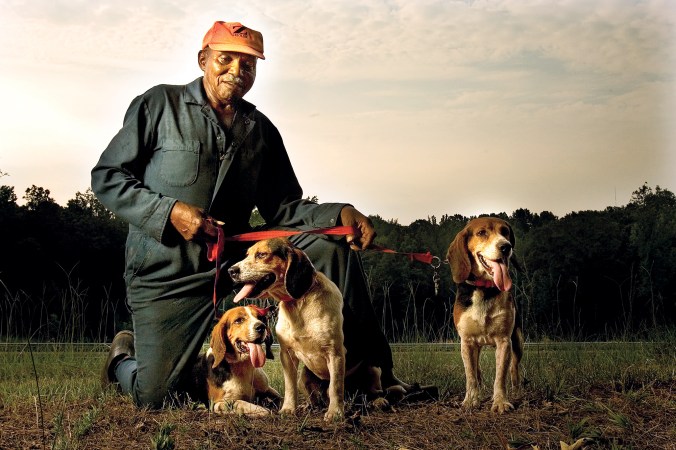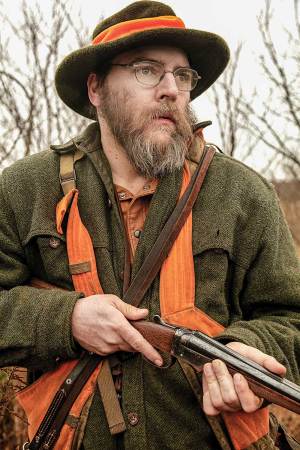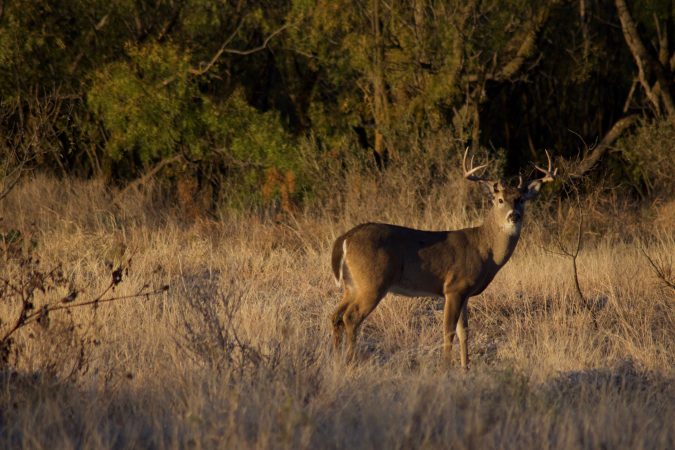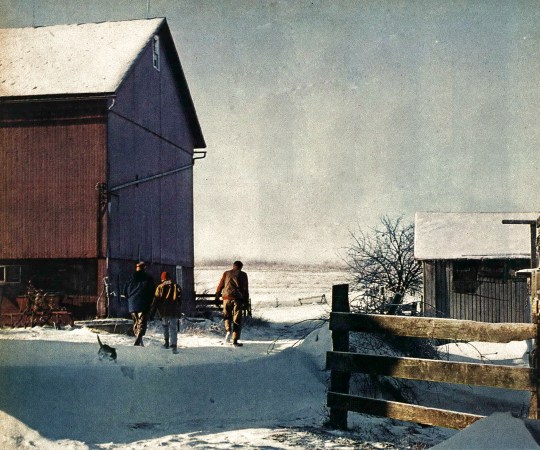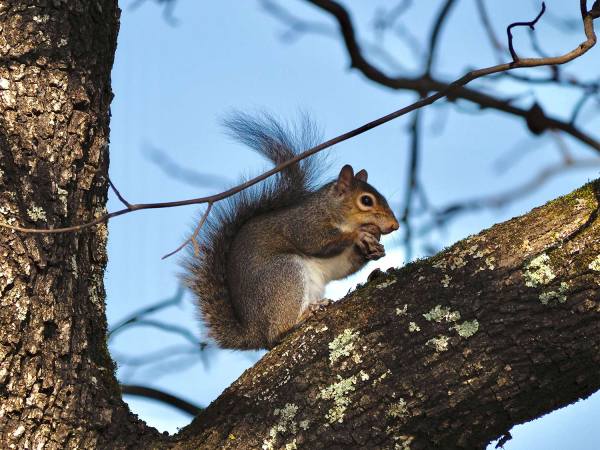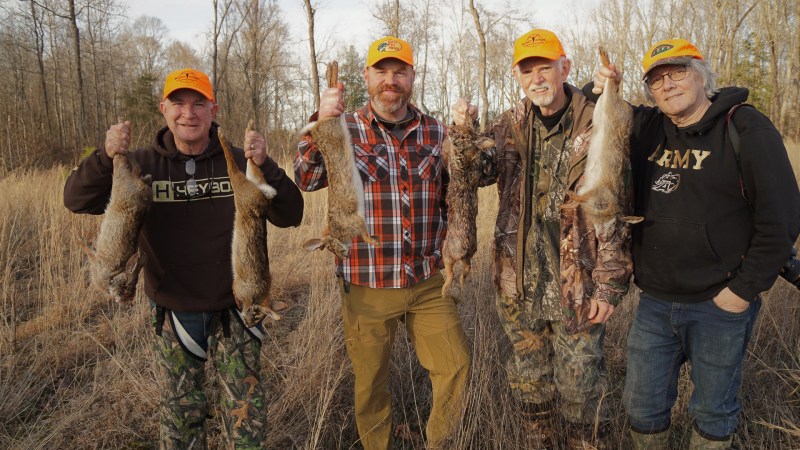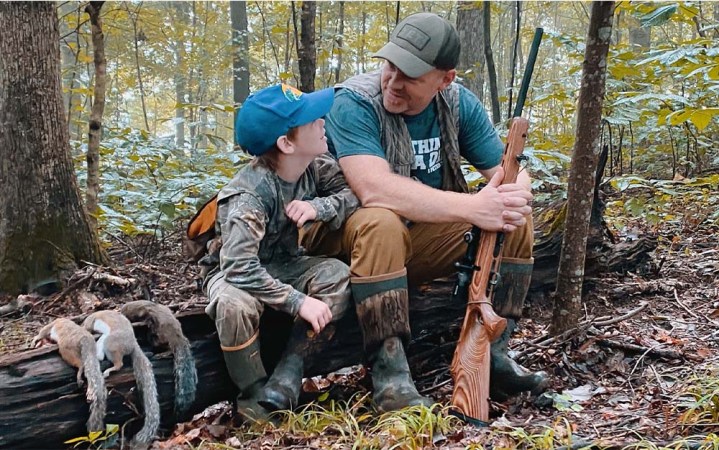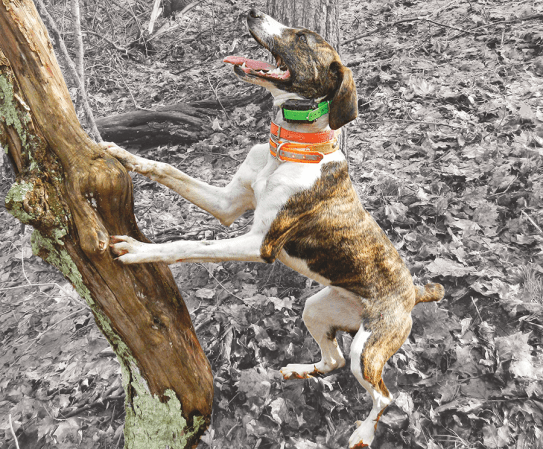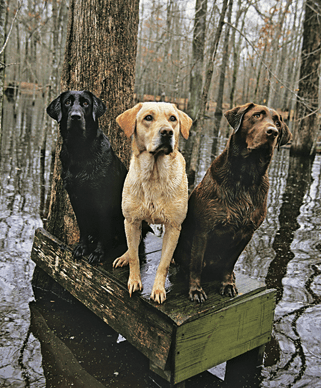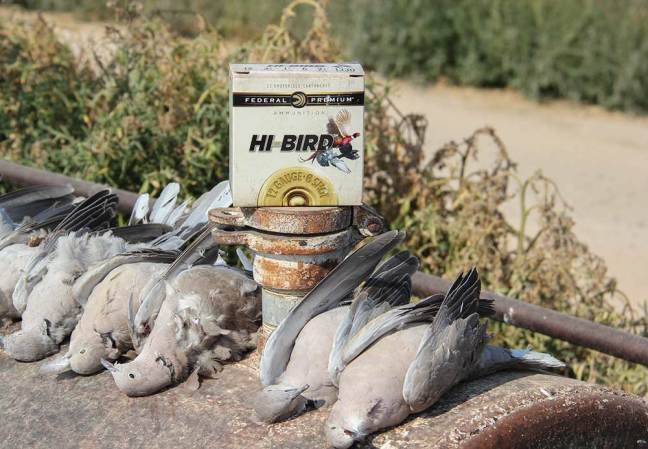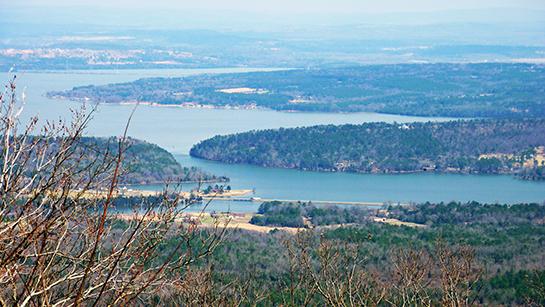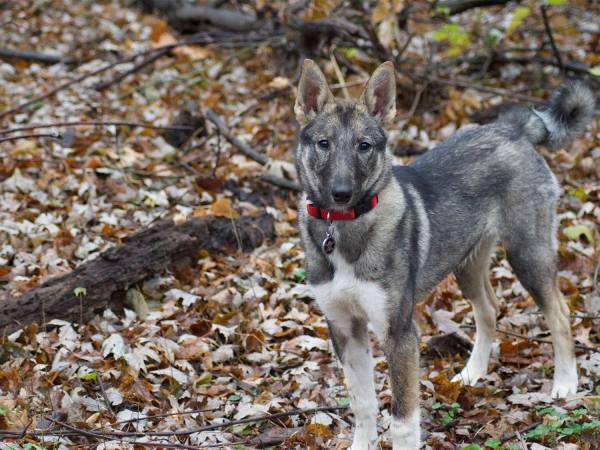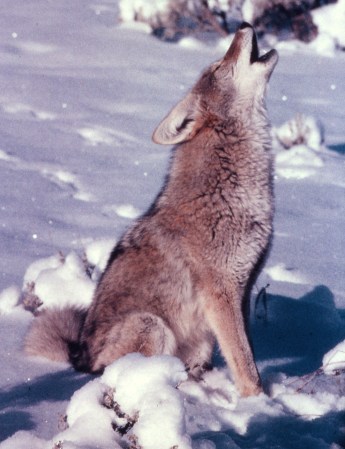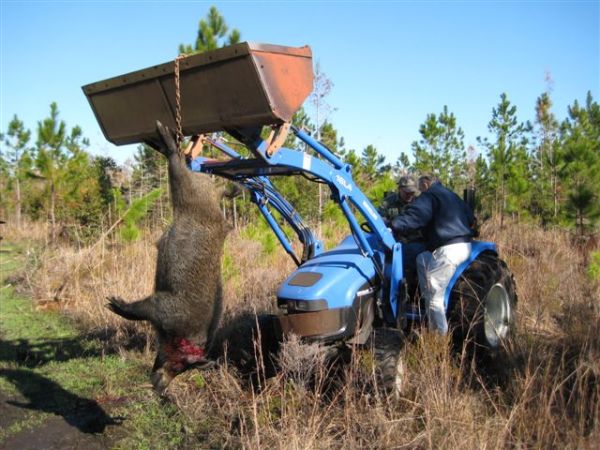“If that dog trees, you can believe there’s a squirrel up there somewhere.”
Harold Knight sounds convinced as he heads toward the source of the commotion. Voicing an unbroken series of chopping barks, Little Stubby, a mountain feist squirrel dog, is standing on his short hind legs with his forepaws leaning against a tall white oak. He followed a gray squirrel’s scent line or he saw it scamper up the oak. Either way, he’s positive.
More frantic barks implore the hunters to hurry up. Ronnie Coffey and Jeff Cochran are armed with 20-gauge shotguns loaded with high-brass No. 6s and Knight with a very deadly .17 HMR bolt-action Savage. Coffey and Cochran handle the runners and jumpers, while Knight takes care of the bushytails that decide to hunker down.
Little Stubby continues to fidget around the tree as Cochran arrives and begins to shake a grapevine trailing down from the oak. The ensuing commotion in the leafless canopy causes the squirrel to scramble upward a few more feet. This squirrel’s gray coat plastered against the trunk isn’t easy to spot, but Knight finds it through his scope. Knight yells out that he sees it and draws a bead. The rifle cracks and the bushytail tumbles down through the branches.
Hunting Squirrels in the Winter
Little Stubby picks up the limp squirrel in his mouth and walks to within a few feet of Coffey, where he drops it unceremoniously on the mat of leaves and returns to minesweeping the forest floor. It’s the treeing part, not a squirrel’s end, that interests him the most. The dog’s pointed ears alternately come to full attention as he listens and watches, then droop when he is on the move in a series of zigzagging spurts. He pauses occasionally to vacuum scents off the forest floor and periodically scans the terrain ahead. To him, the trees of the forest are extensions of the ground, albeit ones that he can’t cross, but his ears and eyes go where his legs can’t.
It’s late February, and the group is hunting some of Knight’s property in southwestern Kentucky. Squirrels are abundant in this part of the state, though fairly underutilized when deer season kicks in and most hunters swap their shotguns and .22s for deer rifles and bowhunting gear. February is the last month of Kentucky’s two-part squirrel season that begins in August, and dreams of monster bucks go into hibernation as interest in bushytails revives.
Hunters who use dogs consider late winter and early spring the best time to hunt squirrels because the leaves are off the trees, making the little rodents easier to spot whether they’re moving or not. And thanks to seasons that extend into January and February, hunters in several southern and midwestern states can take advantage of cold-weather squirrel hunting.
A Heavy Fall Mast Crop Leads to Squirrels Galore
Biologists who study such things tell us that the reason the mast crop is so unpredictable each year is due to the fecundity of the squirrel population. If given a steady food supply, squirrels and other critters that depended on nuts would flourish to levels that threaten tree propagation. The multiplier effect of successive generations would decimate the natural food supply, including the mast a forest depends on for regeneration. Hence, nothing is guaranteed, and it’s feast or famine for gray and fox squirrels.
The squirrels on Harold Knight’s farm have been eating well. For the previous two years, there have been bumper crops of nuts in this corner of Trigg County, according to Knight. Clusters of acorns and hickory nuts, washed down from the ridgelines by recent hard rains, can be seen in all directions. Small wonder there are so many squirrels to hone Little Stubby’s hunting skills, and he’s making the most of the chance to range over new country.
The History of the Mountain Feist
Like his father Stubby, Little Stubby wears the perfect camouflage. He’s a shadow on a zipline, with a black brindle coat blotched with white at the chest. His color blends with the striped bars of light and dark cast by the bare branches on this sunny February morning. Compact, but deep-chested, he has the build of a hunting dog bred to move quickly over steep terrain.
Little Stubby’s forbearers originated in the rugged frontier of the southern Appalachians, though the details of their ancestry are sketchy. George Washington knew about them, as reflected in his correspondence to fellow Virginians regarding the dogs’ merits. Some fans claim the breed began as a mix of European and Native American stock. Regardless of their origins, the dogs wound up being called “mountain feists” and were expected to work for a living.
The utilitarian breed was used for everything from serving as watchdogs, to gathering scattered stock, to rabbit hunting, to treeing various small game intended for the pot. The breed designation came later. At some point, mountain feists were separated from their larger cousins, mountain curs, and they became associated mostly with squirrel hunting. A Heinz 57 of a dog in looks, the mountain feist distinguishes itself more by its ability to see, smell and hear squirrels, and tree them in workmanlike fashion, than any particular physical attribute. Size-wise, they’re runts.
Stubby is 5 years old; his son Little Stubby is almost 3. At 30 pounds and 18 inches tall, Stubby is at the top end of the breed’s average size. Little Stubby measures 16 inches tall and weighs 24 pounds. As their names imply, both dogs display a fairly common trait of the breed. Their tails are about half-grown, as if their development had somehow stopped in the process of being formed.
“It’s pretty common,” Cochran says of their physical shortcoming. “Some feists are born without tails, some with full tails and others with tails somewhere in between.” Lacking a tail doesn’t diminish a feist’s value to its owner. Pound for pound, perhaps no hunting dog fetches as much money as a top-notch mountain feist. Coffey was offered $5,000 for Little Stubby by a hunter who was impressed by his drive and ability. No sale.
Little Stubby is what hunters who appreciate such things would label a “natch’l-born hunter.” He jukes this way and that in and out of the hollows, seemingly at random, but trying to pick up the scent of a squirrel whose own travels that morning were scattered as it feasted on the abundance of acorns and pignuts littering the ridgelines. There are lots of grays and Little Stubby doesn’t miss any that have been on the ground searching for breakfast.
A Southern Squirrel Hunting Tradition
Knight and his buddies enjoy it all. Though the famed call maker and big game hunter is known more for his turkey- and deer-hunting exploits, Knight never passes up a squirrel hunt if he can help it. He comes by his addiction honestly, having grown up a country boy in the wooded hills between the Tennessee and Cumberland rivers before they were dammed to create Kentucky Lake and Lake Barkley. His childhood included many mornings and afternoons squirrel hunting, not so much for recreation’s sake but as a way to put meat on the family table. Cochran and Coffey are variations on the same theme, and share that commonality with millions of hunters whose first lessons were taught in a squirrel woods.
Knight first crossed paths with Cochran a few decades ago at a turkey-hunting seminar in Morehead, Ky. Though their conversation eventually weaved its way around from gobblers to squirrel dogs, the pair never hunted squirrels together until a few years ago. Cochran and Coffey go back farther.
They met after Coffey, decided to buy a feist puppy that Cochran’s Black Bottom Kennels in Worthington, Ky., had for sale. Once the transaction was complete, Coffey named his new squirrel hunter “Little Stubby,” not knowing that the puppy’s father had prior claim to the name. Cochran was willing to let Little Stubby hunt with Stubby, and the two men became good friends in the process. Each year, their hunting begins on the backend of what country people in Kentucky call “Mulberry Season,” when Indian summer softens into autumn and the trees start to shed their leaves.
This Trigg County hunt with Knight comes at the end of a long squirrel season for Little Stubby and his sire. Even so, they don’t lack for enthusiasm. In plain fact, Stubby and son don’t like each other when they’re hunting. When Little Stubby is put in his carrier before lunch for a rest and his father is released, they growl and snarl at each other in passing. It’s pure jealousy, says Cochran, and common for such dogs that are so competitive. Little Stubby earns his keep and his rest. During his time in the woods, he treed more than a dozen grays, compared to half that many for the patriarch of the family. In all fairness, however, dad was released into the same half-mile patch of woods that Little Stubby had previously scoured.
Knight is duly impressed. Just before quitting time, Knight and Coffey start talking about the feasibility of the former acquiring his own squirrel dog. Coffey informs him that he’s going to put Little Stubby at stud and asks Knight if he wants one of the puppies.
“Maybe…we’ll see,” says Knight. Then he moves up the ridge toward the sound of a fresh series of barking. Stubby has treed the last squirrel of the morning.
Where to Hunt Late Winter Squirrels
Although most other types of hunting are put on hold when deer season kicks in, small game hunters nevertheless have plenty of opportunities to go after bushytails before and after whitetails take center stage.
Whether they have treeing dogs or do all the work themselves, hunters can take advantage of generous season and bag limits through winter and early spring in those states where hardwoods and mast crops support healthy squirrel populations. Typically, daily bag limits range from five to eight squirrels.
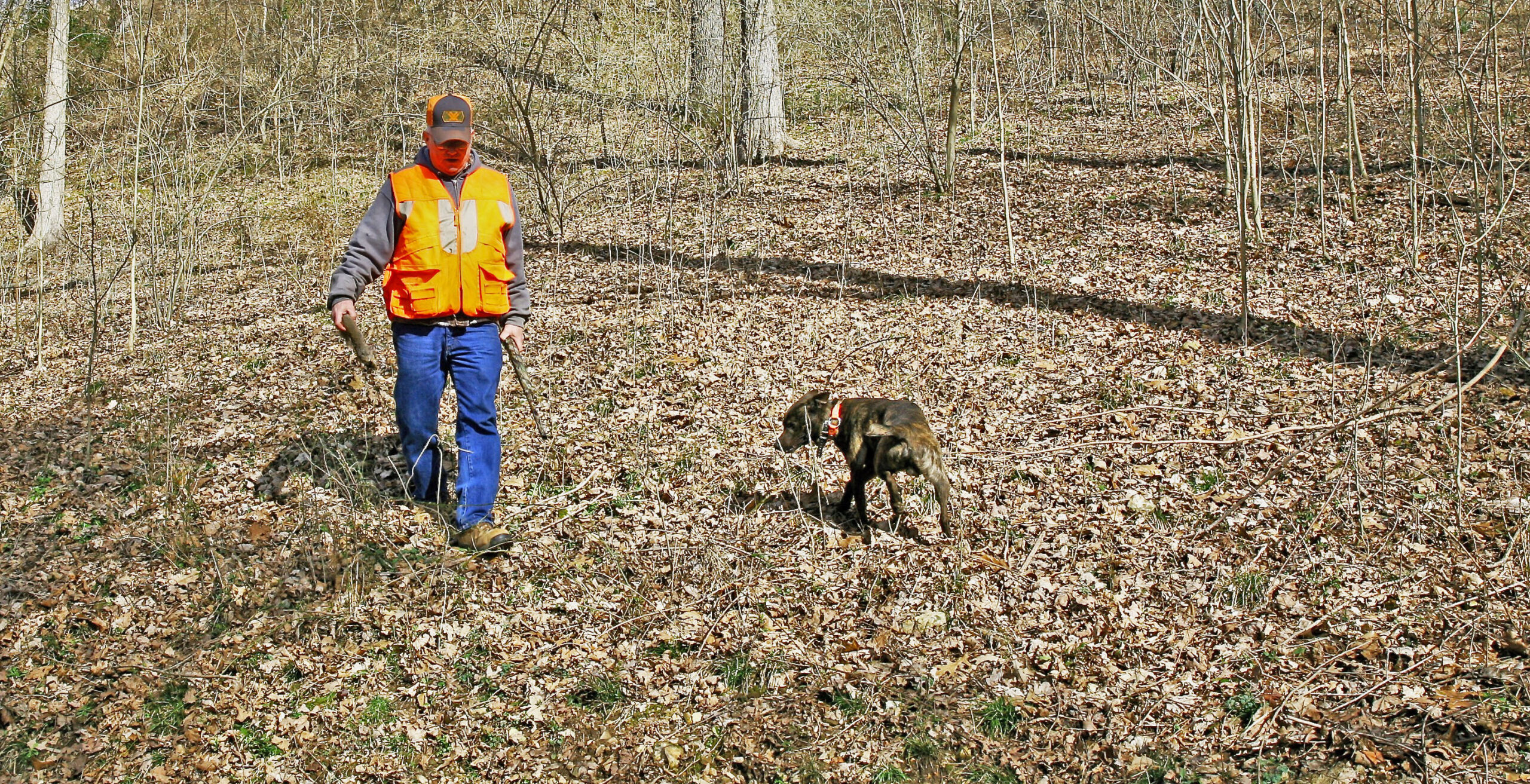
The following is a sampler of late winter or early spring squirrel season dates in states where hunting bushytails is popular. Seasons end prior to the opening of spring turkey seasons and, in some states, are closed temporarily in winter during special deer hunts on wildlife management areas. Remember that in many states, squirrel hunters are required to wear hats, vests or coats displaying blaze orange. Also, keep in mind that most 2020-2021 hunting season dates aren’t locked in yet by state game and fish commissions. Check updated state regulations before the new seasons kick in.
Another caveat: Season dates on state and federal lands are likely to vary from private lands to accommodate different types of hunters. Still, where squirrels are concerned, most states follow the same general script from year to year:
Alabama
Mid-September through the first week in March of the following year. Squirrels may be hunted with dogs by licensed hunters except during closed deer-hunting seasons that vary on public lands. www.outdooralabama.com
Arkansas
Mid-May through February of the following year. Dogs may be used for hunting squirrels except during firearms deer hunts where and when dogs are not allowed. See local restrictions. www.agfc.com
Florida
Mid-October through February. Season dates and bag limits do not apply to the 160 state wildlife management areas. Gray squirrels may be taken during archery and muzzleloader gun seasons with corresponding equipment. Taking fox squirrels is prohibited. www.myfwc.com
Georgia
Mid-August through mid-March. Dog training on wildlife management areas is allowed during corresponding hunting season, unless otherwise noted in published restrictions. www.georgiawildlife.com
Illinois
The first of August through mid-February (with a four-day break during firearm deer season during the third week in November and again the first week in December). There are more than 200 Public Hunt Areas, many of which support large populations of squirrels. Some rules pertaining to the use of dogs are site-specific. www.dnr.illinois.gov
Indiana
Mid-August to the end of January. Running squirrels with dogs is legal year-round, although a hunting license is required and squirrels may be taken only during hunting season. Other restrictions apply on some DNR-administered lands. www.in.gov/dnr/fishwild
Kansas
June through February. Hunting with dogs is permitted throughout the season, though some restrictions may apply on public land. www.ksoutdoors.com
Kentucky
Mid-November through February. Various state and federal lands are available. Hunting squirrels with dogs on wildlife management areas is legal during the spring season. Other restrictions might apply on public land. www.fw.ky.gov
Louisiana
Early October through February and again in May. Spring squirrel season is closed in the Kisatchie National Forest, national wildlife refuges, U.S. Army Corps of Engineers property, and some state wildlife management areas. Check schedules specific to the site. Small Game Emphasis Areas are available throughout the state. www.wlf.louisiana.gov
Maryland
The first week in September through February. Only deer may be hunted on the opening day of deer firearms season in respective zones, except for sea ducks. www.dnr.maryland.gov
Michigan
Mid-September through March. Dog-training season is July 8 through April 15 of the following year on state-owned lands and no hunting license is required. www.michigan.gov/dnr
Minnesota
Mid-September through February. Otherwise, dog-training season is mid-April to mid-July. During deer hunting seasons, some state or federal lands might be closed temporarily to small game hunting. See state regulations for details. www.dnr.state.mn.us/fishwildlife
Mississippi
October 1 through February. Free permits to hunt with squirrel dogs are available for Homochitto National Forest. Rules for other state and federal lands vary. www.mdwfp.com
Missouri
Late May through mid-February. In some counties, dogs are prohibited from squirrel hunting during the November portion of the firearms deer hunting season. However, squirrel hunting with dogs is legal during the November portion of the firearms season in Butler, Carter, Dent, Iron, Madison, Oregon, Reynolds, Ripley, Shannon, and Wayne counties. Dog training is permitted provided no game is taken. www.mdc.mo.gov
Nebraska
August 1 through January, with some exceptions on public lands. Open Fields and Waters (OFW) lands, mainly in the southern part of the state, are closed to squirrel hunting during the nine-day rifle deer season in November. www.outdoornebraska.gov
New Jersey
Mid-December to mid-February (Sundays excluded), except during the statewide six-day firearms deer season in December, on the Wednesday of the Permit Shotgun deer season, and as restricted on public lands. Training season runs from Sept. 1 to April 20 on WMAs, with some restrictions related to deer seasons. Muzzleloader squirrel zones have been established in the western and northwestern portions of the state. www.state.nj.us/dep/fgw
New York
September 1 through the end of February in most of the state. On Long Island and Staten Island, the season begins November 1 and runs through February. Dog-training season on public lands is mid-August to mid-April, subject to local stipulations. www.dec.ny.gov/outdoor/hunting.html
North Carolina
Mid-October through February. Hunting squirrels with dogs during the season is allowed in all counties of the state, subject to local restrictions. www.nc.gov/wildlife-resources-commission
North Dakota
Mid-September through early January. Squirrel hunting is permitted on some federal lands, but restrictions and seasons vary. www.gf.nd.gov
Ohio
September 1 to the end of January. The squirrel season is closed statewide during the seven-day firearms deer season that begins in early December. www.wildlife.ohiodnr.gov
Oklahoma
Mid-May to the end of January. Seasons on public lands may vary from statewide dates. www.wildlifedepartment.com
Pennsylvania
December 26 through February. Sunday hunting for most species is prohibited. Squirrel seasons are closed during firearms deer seasons. www.pgc.pa.gov/HuntTrap/Hunting
South Carolina
Training season (no guns) is March through September; hunting or training Oct. 1 through February. On WMAs, training season extends from September 2-14, while hunting season runs from Oct. 1 through February. No Sunday hunting is permitted on WMA lands. www.eregulations.com/southcarolina/huntingandfishing
South Dakota
September 1 through February. The eastern fox squirrel is the predominant species. www.gfp.sd.gov/hunt
Tennessee
Late August through February. Otherwise, squirrel dog training is permitted year-round on private land. Training on wildlife management areas (where permitted) requires a small-game permit. www.tn.gov/twra.html
Texas
East Texas (51 counties): Oct. 1 through the third week in February. In 157 other Texas counties, the hunting season is year-round. www.tpwd.texas.gov
Virginia
Early September through February for gray squirrels; early September through January for fox squirrels in counties west of the Blue Ridge and other designated counties. Training dogs to hunt squirrels is permitted during daylight hours only and hunting licenses are required. Gray squirrels may be harvested on most wildlife management areas; some restrictions apply to fox squirrels on certain wildlife management areas. www.dgif.virginia.gov/hunting
West Virginia
Mid-September through February. Otherwise, in counties that have a whitetail buck firearms season, it is illegal to hunt small game during the first three days of the season. Hunting is permitted on National Park Service lands, Wildlife Management Areas and State Forests, National Wildlife Refuges, and National Forests. www.wvdnr.gov/hunting/licensing.shtm
Wisconsin
Mid-September through January. Dog training is also allowed on some Department of Natural Resources lands. www.dnr.wi.gov
